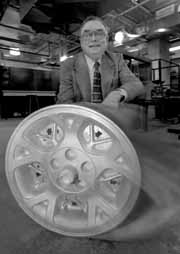
| ||
 | ||
 Professor John Gruzleski in his foundry laboratory with a raw casting of an aluminum wheel PHOTO: OWEN EGAN |
Prized partnership keeps on rolling
|
SYLVAIN COMEAU | Professor John Gruzleski isn't afraid of commitment. He has been a partner in a long-term relationship and says the experience has been satisfying for both parties -- it has even provided benefits for McGill.
Gruzleski's significant other in this case is a company called Timminco Limited, with whom the mining and metallurgical engineering professor has been doing research for almost 20 years. Last fall, Timminco, which produces specialty metal alloys, and Gruzleski were honoured with the Synergy Award "for outstanding achievements in innovation and wealth creation." The award, including a $10,000 research grant for Gruzleski, is sponsored by the Natural Sciences and Engineering Research Council (NSERC) and the Conference Board of Canada. It recognizes a fruitful collaboration which began in 1980 before NSERC had even started to sponsor industry-university research. "Back then, collaborations like this were quite unusual," says Gruzleski. "NSERC started to develop their industry-university programs about two years later. Today, I think the Department of Mining and Metallurgical Engineering is still a leader in industry-university synergy, although it's much more in vogue across the country." With traditional research funding sources drying up, universities have had to look to the private sector for support. Gruzleski acknowledges that not everyone is comfortable with the idea of working closely with industry, but says stories like his might prove reassuring. It all began with a chance meeting aboard a commuter train. Gruzleski bumped into a McGill graduate, then working for Timminco, who told him of a problem the company was having. They were attempting to devise a way of using the element strontium to improve the ductility and strength of aluminum castings for airplane and automobile parts. All the experiments had failed. By the end of the train ride, the two had agreed to test the process in a McGill foundry laboratory. "There's a large measure of luck in research. If that meeting on the train had never happened, my career would have taken quite a different direction. I'm a great believer in fate." Maybe fate did take a hand in the team's progress; a breakthrough early in the game helped generate15 years of momentum. "In the first 18 months of the process, we found out that the company's initial attempt failed because they were not adding the strontium in the right form. It wasn't dissolving in the liquid aluminum," says Gruzleski. "They had attempted to add pure, elemental strontium, which is a very reactive element. In the aluminum, it was forming oxides and hydroxides, which would form an outer, protective layer; the layer would prevent it from dissolving. So we decided that we had to dilute the strontium first. While you can dilute it with a lot of things, the most logical thing to use was aluminum. So we developed a strontium-aluminum alloy, and it worked." From there, working with McGill graduate students, Gruzleski and Timminco engineers continued to refine the technique. They saw the worldwide demand for strontium grow from almost zero to 300 tonnes a year by 1990. The timing was right because of the growing demand for aluminum castings. "Several factors came into play. We started to work on this at the end of the 1970s energy crisis, when people realized that energy would no longer be cheap. So there was a beginning of a very steady increase in the use of aluminum in automobiles to meet demands for lighter weight transportation." Another factor, Gruzleski says, was Timminco's aggressive marketing plan. "Very often, companies who engage in research with universities don't follow up on the results. This was certainly not the case here. Timminco would take our results, show them to customers and demonstrate how it could improve their products. "Sometimes the customer would try it and find a problem, and that would give us something else to work on. Then our solution was once again shown to the customer. So technology transfer was very rapid because we kept lines of communication open." Anticipating a saturated market for current applications, Timminco and Gruzleski are working on new uses for strontium -- which may again yield environmental dividends by improving the recycling of aluminum. "Recycled aluminum is generally used for lower grade applications because aluminum is hard to purify in the recycling process. Other materials like iron can't be removed when it's melted down. Generally, recycled aluminum goes into die cast metals, used for decorative objects or less important parts of a car, such as door handles. If a door handle falls off, it's annoying but not life threatening." The team is working on using strontium to make secondary or recycled aluminum alloys of high enough quality for crucial components like engine parts. "Impurities like iron are difficult to remove from aluminum, but we have had some success in using strontium to change the microstructure of recycled aluminum to make it resilient and reliable enough for demanding applications." Whether or not they succeed, the spinoffs from the research to date have been "huge," Gruzleski says. "This was an investment of taxpayers' money which has benefited everybody. The company constructed a new plant for producing strontium as a result of the increased market, so jobs have been created -- one of the things politicians always like to think these things do and sometimes they actually do! "It has also been instrumental in the training of large numbers of master's and PhD students who are now in academia and industry in many different countries. In that sense McGill has benefited as well. We've been able to write the classical textbook on the treatment of liquid aluminum alloys, now used in foundries around the world. "I think all that is just as interesting as the science."
|
|
| |||||